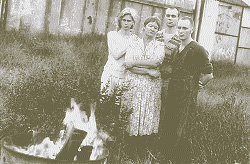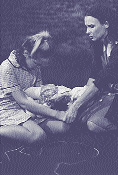Monstrous family show
Nikki Heywood and Keith Gallasch in a dialogue about Burn Sonata

Claire Hague, Clare Grant, Dean Walsh and Benjamin Grieve
photo Heidrun Löhr
Claire Hague, Clare Grant, Dean Walsh and Benjamin Grieve
At the beginning of our talk, Nikki Heywood shows me a series of photographs of the performers from Burn Sonata, realistically costumed and posed as a family group in front of a fire in a 44 gallon drum in a suburban backyard. The performance looks at the monstrous in us and in domestic violence in particular. I’d just been to see Hilary Bell’s emotionally and morally demanding play Wolf Lullaby at The Stables (Griffin Theatre Company) in which a nine year old murders a younger child.
KG Your work has a rich symbolic power, archetypal female figures and chains of metaphor like the human-insect analogy in Creatures Ourselves. This new work looks like a leap into something more social, more literal.
NH I don’t see it as a departure. I think Creatures grew out of a big question I had about how women use their power and transferred that into looking at insects and at human beings as creatures. Women have occupied a place of no power and, given power, there’s something very terrifying that happens. It’s an area people like Camille Paglia have looked at, and she has proven very unpopular with a lot of feminists. But I think it could bear a lot of further investigation. I was looking at what we consider to be monstrous and how we relate to it, and whether or not we place it inside or outside ourselves. At that time there was a lot in the media about serial killers. Like a lot of people, I am very interested in that impulse to kill.
I’d been thinking about my father and the fact that I’d decided I didn’t want to see him again for quite a long time, if ever. Then I heard that he was in hospital having an operation. Of course, it called on my sense of guilt and of duty as a daughter. I sat thinking, well, if I go to the hospital and visit him, what will happen? I imagined him lying in bed, and I imagined him on a life support system, which of course he wasn’t because it wasn’t that serious. But that was the image I had and I just let the story run. And the story went that I walked into the room, felt nothing for him and switched off his life support system. At that moment, I thought “That’s really satisfying. That would just complete something for me, to do that. Okay, I know I could kill someone”. And I remembered I had dreams about killing my father when I was a child.
KG Archetypal father or actual father?
NH The actual father. I’m not alone in that. There are a many people who’ve had that difficulty with one or other of their parents. A lot of murders happen in families. But the interesting thing is, it’s very hard to find a case where a daughter murders her father. And that seemed to me to be like a big taboo. Even in Greek mythology, I still haven’t really found the story. The father is God. If the daughter, in terms of hierarchy, was to turn the tables and to kill God, what happens?
KG I’m curious about the naturalism of the photo images you’re showing me.
NH Well, the inclination’s there and I’m trying to subvert it and find other than naturalistic ways to occupy the performing space that re-create that energy of violence, of dysfunction. When we’re not functioning well as adults we all occupy again the place of the child. There’s a schism created for us through a childhood experience, and that experience will continue to operate out of that fracture, in some way or another, until we find a way of resolving it.
KG When Open City performed Promiscuous Spaces: Table Talk at A Progressive Dinner, (The Performance Space, April) I spoke about my obsessive horror-story-telling behaviour at the dinner table, about how here I am at 50 behaving like someone who was traumatised at an early age. But it wasn’t a big one-off trauma. At one performance, because the work is semi-improvised, I suddenly invoked Sartre’s notion of serial trauma, of recurrent events (like a decade of family rows over meals) that cumulatively shape the psyche.
NH I thought I might look at what happens when a child tells a story or does a drawing, the act of transference where they become another character or an animal. One of the performers, Claire Hague, has worked as a visual artist, so I’ve been talking to her about it especially since in the performance she occupies my place as a child, that place of no power, in a sense, like that of the youngest daughter.

Lucy Bell and Tara Morice in Wolf Lullaby
photo Robert McFarlane
Lucy Bell and Tara Morice in Wolf Lullaby
KG In Wolf Lullaby, as soon as you enter the theatre you see the walls that surround you are covered in a dense child’s blackboard scrawl along with the erased shape of a wolf. The child is a murderer. Her parents are not oppressive, they just have no idea what their daughter is, no way of responding to her ‘cries for help’—her nightmares are ‘comfortingly’ dismissed. They haven’t created a monster, they’ve got one. Of course, sooner or later they suspect the ‘monstrous’ is in them, that their daughter has inherited it. But there is no genetic or psychological consolation from the writer for either the parents or the audience. Because the parents share a kind of bland optimism, a belief in childhood innocence, they both figuratively and literally don’t see the writing on the wall. The moment when the child, played by Lucy Bell, furiously draws a wolf on the wall, is truly frightening. I haven’t been frightened by anything in conventional theatre for years.
NH I don’t want the space to be cluttered with drawings. I want it to be meaner than that.
KG It helps the stage play because it’s a real challenge to convey the enormity of the child’s vision, the wolf which she both is and fears, without resorting to too many words or a symbolic poetry. It’s a beautifully spare text.
NH What do you as a child do when you recognise that you’re living with a monster, whether its yourself or a parent? Can you recognise the monstrous for what it is?
KG It’s bound up with affection and the desire to love the parents. When I performed Photoplay in 1988, a work about my relationship with my emotionally tyrannical mother it was a very difficult experience even though she was long dead. The work turned out to be an exorcism-in-progress.
NH Jean/Lucretia (1995), my work about my grandmother was a very private, personal thing, a lament. That’s when I started to recognise that I really don’t feel I can make work until it rises almost like some sort of bubble. The fact that it’s about my family is not pre-determined. It’s just that it’s happening.
KG Your work is very distinctive, it doesn’t read as Butoh even though your training is in that area through the Body Weather ‘school’ of Min Tanaka. Is Burn Sonata going to combine the archetypal power of your work with the everyday? I’m back at the naturalism issue again.
NH What happens in ordinary life is far more extraordinary than what we create as high art. That was what interested me in Meg Stuart’s dance work at the Adelaide Festival.
KG A Sydney choreographer said to me that Stuart’s dancers weren’t sufficiently in their bodies!
NH The total opposite was the case for me. I felt that I was in their bodies half the time. I noticed that one of the dancers had worked with Min Tanaka. I made a decision a couple of years ago that I wasn’t interested in doing Butoh anymore but Body Weather training is based on everyday sensations and movements. It allows you to access conditions and states on a physical level and transfer that into a work where you’re dealing with a sort of realism. It’s like taking a microscope to the real, or accelerating it by using a different speed, or by amplifying it.
KG You have had some classical vocal training on and off for a couple of years, you perform with the Cafe at the Gate of Salvation gospel choir and you work with sound designer Garry Bradbury. Lately in Sydney it’s been exhilarating to hear the voice emerging in performance works you usually expect to be physical and silent. The vocal work in Creatures Ourselves and Jean/Lucretia was both natural and heightened.
NH Body Weather doesn’t really address the voice, but I think it has influenced my approach to the voice. I feel I’m just scratching the surface. Sound is a fundamental part of the way I construct the imagination of the performance. Garry Bradbury is someone I’ve found who I can work with in a very intuitive way. I talk to him about the thematic content of the work and he invariably has a connection with it. We were working on Jean/Lucretia and I was talking about my grandmother’s house and her pianola and my childhood relationship with it. He’s really fascinated with pianolas so he’s looking at ‘deconstructing’ a pianola and making new rolls based on electronic and possibly vocal sound. The performers have great voices and I’ll want to use them too.
KG With words?
NH I’m not sure how much. I’m just beginning to write text, another surprising development, another way of working. The subject matter is such a juicy area: what is the relationship between the archetypal and the real. The older I get, the more fertile that territory becomes. I remember talking to a psychologist years ago, who said your late 30s, early 40s is actually when the unconscious starts to really become…well, no longer so separate. The dreams get stronger, and anything that’s not resolved actually becomes bigger.
KG You can resolve it through your art?
NH I think you can.
Nikki Heywood, Burn Sonata, with Claire Hague, Tony Osborne, Benjamin Grieve, Clare Grant, Dean Walsh, sound design by Garry Bradbury, The Performance Space, July 25-August 4.
RealTime issue #13 June-July 1996 pg. 30






